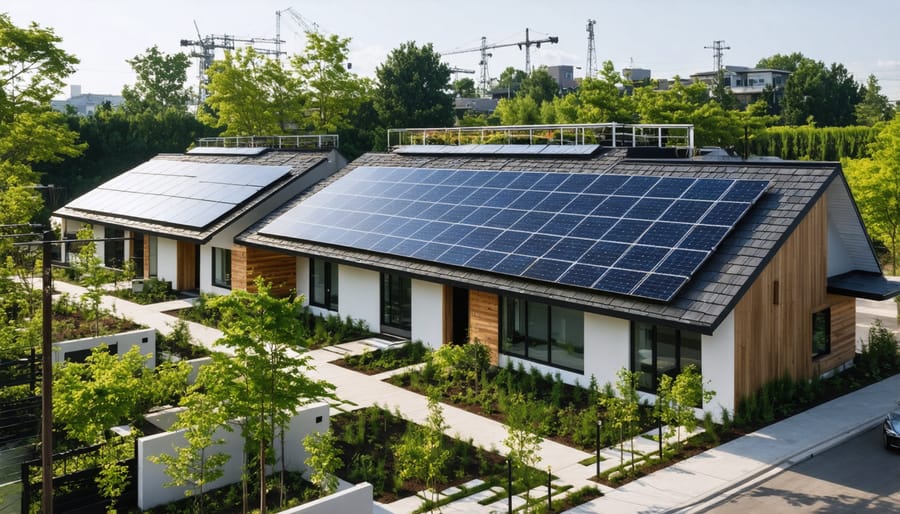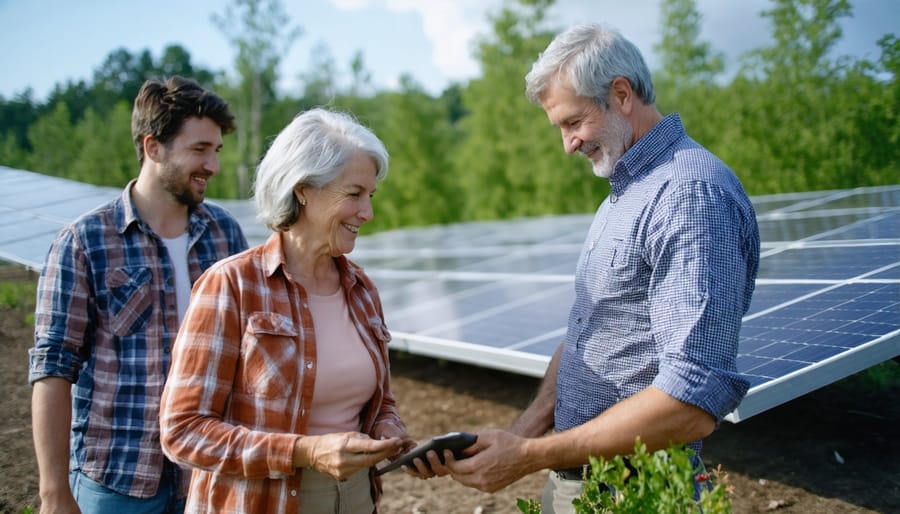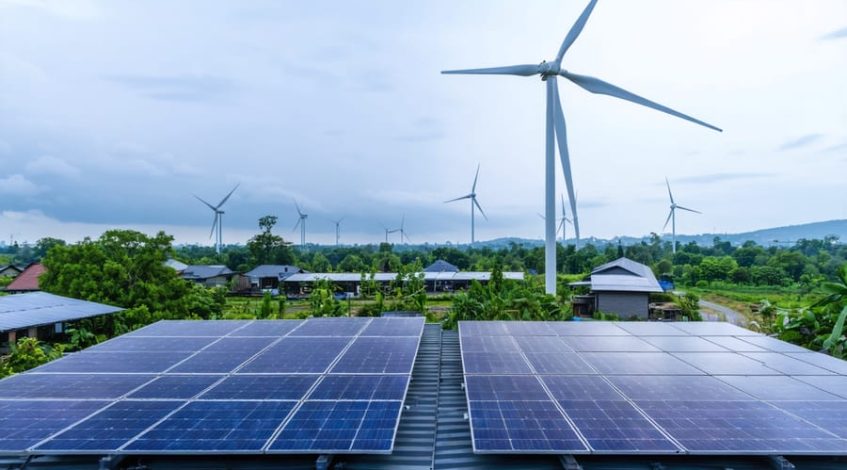Ecological energy systems are revolutionizing how businesses and communities approach sustainability, combining renewable resources with intelligent distribution networks to create resilient, equitable power solutions. This integrated approach delivers both environmental benefits and substantial economic returns, with modern installations achieving payback periods as short as 4-6 years while reducing carbon emissions by up to 70%.
As global energy demands intensify, ecological energy systems offer a strategic advantage by harmonizing technological innovation with natural processes. These systems leverage solar, wind, and biomass resources alongside advanced storage solutions and smart grid technologies to optimize energy flow, reduce waste, and enhance community resilience. Leading organizations implementing these solutions have reported average operational cost reductions of 30-40% while strengthening their ESG (Environmental, Social, and Governance) profiles.
The transformation toward ecological energy represents more than just a shift in power generation—it’s a fundamental reimagining of how we integrate energy systems with natural ecosystems and social structures. Forward-thinking businesses and municipalities are discovering that ecological energy solutions create multiplicative benefits: enhanced grid stability, improved public health outcomes, increased job creation, and stronger community engagement, all while advancing climate action goals.
The Foundation of Holistic Energy Ecosystems
Interconnected Energy Networks
Modern integrated energy systems function like a well-orchestrated ecosystem, where various renewable sources complement each other to ensure reliable power supply. Solar panels generate electricity during daylight hours, while wind turbines maintain production during nighttime and cloudy conditions. Hydroelectric facilities act as natural batteries, storing excess energy through pumped storage systems and releasing it during peak demand periods.
Smart grid technologies enable seamless coordination between these sources, automatically adjusting output based on real-time demand and weather conditions. Energy storage solutions, including advanced batteries and thermal storage systems, bridge gaps in production and maintain grid stability. This interconnected approach maximizes efficiency and reliability while minimizing waste.
For example, Denmark’s energy network demonstrates this synergy by combining offshore wind farms with neighboring countries’ hydroelectric capabilities, creating a robust and resilient power system. This model of interconnection not only enhances energy security but also reduces costs through improved resource utilization and shared infrastructure.
Community-Scale Implementation
Community-scale implementation of ecological energy systems creates resilient, self-sustaining neighborhoods through integrated local generation and distribution networks. These systems typically combine solar arrays, wind turbines, and energy storage solutions to power multiple buildings or entire districts. Smart microgrids enable efficient energy management, allowing communities to share resources and reduce dependency on traditional power infrastructure.
Successful implementations often start with comprehensive energy audits and community engagement to determine optimal system sizing and placement. Local energy cooperatives and public-private partnerships have emerged as effective models for financing and managing these installations. For example, the Brooklyn Microgrid project demonstrates how blockchain technology can facilitate peer-to-peer energy trading within neighborhoods.
Key components of community-scale systems include distributed generation facilities, smart meters, grid automation technology, and energy management systems. These elements work together to balance supply and demand, maintain grid stability, and optimize energy use across the community. Implementation typically requires coordination between utilities, local governments, and community stakeholders to address regulatory requirements and ensure equitable access to clean energy resources.
The benefits extend beyond environmental impact, including increased energy security, reduced transmission losses, and local economic development through job creation and reduced energy costs.

Social Equity Through Energy Democracy
Access and Affordability
Integrated ecological energy systems are revolutionizing access to clean energy by creating more affordable and equitable solutions for communities worldwide. Through smart grid technologies and distributed generation networks, these systems reduce infrastructure costs while increasing reliability and accessibility.
The combination of solar, wind, and energy storage systems, when properly integrated, creates economies of scale that drive down costs for end-users. For example, community solar projects have demonstrated up to 40% reduction in energy costs for participants compared to traditional utility rates. Microgrids serving business districts and residential areas provide additional cost benefits through reduced transmission losses and shared maintenance expenses.
Financial innovations are also making ecological energy more attainable. Power purchase agreements (PPAs), lease options, and green financing programs enable organizations to implement sustainable energy solutions with minimal upfront investment. Government incentives and renewable energy credits further enhance affordability, making clean energy accessible to a broader range of businesses and communities.
Digital technologies and smart metering systems optimize energy distribution and consumption patterns, resulting in better resource allocation and reduced operational costs. This technological integration allows for dynamic pricing models that benefit both providers and consumers, creating a more sustainable energy marketplace.
The democratization of clean energy through these integrated systems is particularly impactful in underserved areas, where traditional energy infrastructure may be costly or unreliable. By implementing decentralized solutions, communities can achieve energy independence while supporting local economic development.
Community Ownership Models
Community ownership models are revolutionizing the renewable energy landscape by democratizing access to clean power and ensuring equitable distribution of benefits. These models typically fall into three main categories: cooperatives, community trusts, and municipal partnerships. Each structure offers unique advantages for local stakeholders while promoting sustainable development.
Energy cooperatives, the most common form, allow community members to pool resources and collectively own renewable energy installations. These community solar power initiatives enable participants to share both the costs and benefits of renewable energy projects, making clean energy accessible to those who might otherwise be excluded due to financial or physical constraints.
Community trust models establish independent entities that manage energy assets on behalf of local residents. These trusts often reinvest profits into community development projects, creating a sustainable cycle of economic and environmental benefits. For example, the Danish island of Samsø transformed its energy system through a community trust structure, achieving 100% renewable energy status while generating local employment opportunities.
Municipal partnerships represent a hybrid approach, combining public oversight with community participation. These arrangements often leverage public funding while maintaining community control over project direction and benefit distribution. Successful examples include Seattle’s City Light Community Solar program, which allows renters and apartment dwellers to participate in solar energy ownership while ensuring fair pricing and transparent governance.
Real-World Success Stories
Urban Community Solar Projects
Urban community solar projects have emerged as innovative solutions for delivering clean energy access to city residents while promoting social equity and environmental sustainability. These initiatives typically involve shared solar installations on municipal buildings, parking structures, or dedicated urban spaces, enabling multiple participants to benefit from renewable energy generation.
In Minneapolis, the Green Zones Initiative demonstrates how community solar can address environmental justice concerns while providing affordable clean energy. The project serves over 200 households, with 75% of subscriptions reserved for low-income residents, resulting in average annual savings of $500 per household on electricity costs.
Seattle’s Community Solar Program showcases effective public-private partnerships, utilizing rooftop space on public schools and community centers. This approach has generated 2.5 megawatts of clean power while creating local jobs and reducing energy costs for participating institutions by approximately 30%.
Brooklyn’s Solar Garden Collective represents an innovative financing model where local businesses and residents collectively invest in rooftop solar installations. The program has successfully deployed solar arrays across 15 commercial buildings, generating enough electricity to power 1,000 homes while providing investors with an average 6% annual return.
These projects demonstrate key success factors for urban solar initiatives:
– Strategic site selection considering space optimization and grid integration
– Inclusive financing mechanisms that enable broad community participation
– Clear governance structures for project management and benefit distribution
– Strong partnerships between municipalities, utilities, and community organizations
The scalability of these projects has attracted significant investment, with urban community solar installations growing by 40% annually since 2018.
Rural Energy Cooperatives
Rural energy cooperatives have emerged as powerful drivers of sustainable development, demonstrating how community-owned power systems can transform local economies while advancing ecological goals. These member-owned organizations have consistently shown remarkable success in delivering reliable, affordable renewable energy to areas traditionally underserved by conventional utilities.
Several successful energy cooperatives across rural America showcase this model’s effectiveness. The Farmers Electric Cooperative in Iowa, for instance, generates over 20% of its power from solar installations, while reducing member costs by 12% annually. In Minnesota, the Wright-Hennepin Cooperative Electric Association pioneered community solar gardens, enabling members to benefit from solar power without installing panels on their properties.
These cooperatives typically operate on a democratic decision-making model, where members have direct input into energy sourcing and pricing strategies. This approach has led to innovative solutions like smart grid implementations and battery storage systems that maximize renewable energy utilization while maintaining grid stability.
The economic benefits are substantial: cooperative members often see lower electricity rates, receive annual dividend payments, and benefit from local job creation. Additionally, these organizations frequently reinvest profits into community development projects, creating a virtuous cycle of sustainable growth.
Rural energy cooperatives also demonstrate remarkable resilience during extreme weather events, thanks to their decentralized infrastructure and strong community ties. Their success has inspired similar initiatives worldwide, proving that community-owned renewable energy systems can effectively balance ecological responsibility with economic viability.


Implementation Strategies for Businesses
Assessment and Planning
Successful implementation of ecological energy systems begins with a comprehensive assessment of current energy needs and available resources. Organizations should start by conducting an energy audit to establish baseline consumption patterns and identify opportunities for efficiency improvements. This evaluation should include both quantitative measurements and qualitative factors such as local climate conditions, available space, and regulatory requirements.
The planning phase requires a systematic approach incorporating several key steps. First, establish clear objectives for energy reduction and sustainability goals. Next, evaluate potential renewable energy sources based on site-specific conditions and resource availability. Consider factors such as solar exposure, wind patterns, or biomass accessibility depending on your location.
Develop a detailed feasibility study that includes:
– Initial capital investment requirements
– Expected return on investment (ROI)
– Technical specifications and system requirements
– Implementation timeline
– Operational and maintenance considerations
– Environmental impact assessments
Engage stakeholders early in the planning process to ensure buy-in and address potential concerns. This includes facility managers, financial officers, local authorities, and community representatives. Create a phased implementation strategy that allows for gradual transition while minimizing disruption to existing operations.
Consider partnering with experienced energy consultants or system integrators who can provide valuable insights and help navigate technical challenges. They can also assist in identifying available incentives, grants, or tax benefits that can improve project economics.
Financial Models and ROI
Investing in ecological energy systems requires careful financial modeling to ensure optimal returns and long-term sustainability. Recent market analyses show that renewable energy projects typically deliver ROIs ranging from 10-20% annually, with payback periods averaging 4-7 years for commercial installations. These figures improve significantly when factoring in government incentives, tax benefits, and rising conventional energy costs.
Successful business energy cost optimization through ecological solutions often follows a three-tier investment model: initial infrastructure development, system integration, and ongoing optimization. Solar installations, for instance, demonstrate consistently strong returns, with commercial systems showing average ROIs of 15-25% over their lifetime when properly maintained.
Investment options vary from direct ownership to power purchase agreements (PPAs) and lease arrangements. Each model offers distinct advantages: direct ownership provides maximum long-term savings, while PPAs offer immediate cost reductions with minimal upfront investment. Energy performance contracting (EPC) presents another viable option, where savings are guaranteed and used to finance the initial investment.
The most successful implementations combine multiple renewable sources with smart storage solutions, creating resilient systems that maximize financial returns while minimizing environmental impact. Case studies from manufacturing facilities show that integrated ecological energy systems can reduce operational costs by 30-40% while providing emergency power security and carbon credit benefits.
The transition to ecological energy systems represents a pivotal shift in how we power our communities and businesses. Throughout this exploration, we’ve seen how renewable energy technologies, smart grid integration, and sustainable practices work together to create resilient and environmentally responsible energy solutions. The evidence clearly demonstrates that ecological energy systems not only reduce environmental impact but also offer compelling economic advantages through reduced operational costs and enhanced energy security.
Looking ahead, the future of ecological energy appears increasingly promising. Technological advancements continue to improve efficiency and reduce implementation costs, while policy frameworks worldwide are evolving to support sustainable energy adoption. Business leaders and facility managers who embrace these solutions now position themselves at the forefront of this transformation, gaining competitive advantages while contributing to global sustainability goals.
The success stories and case studies presented highlight the practical feasibility of ecological energy systems across various sectors. From manufacturing facilities to office complexes, organizations are proving that sustainable energy solutions can deliver both environmental benefits and strong returns on investment. As storage technologies advance and smart grid capabilities expand, the potential for comprehensive ecological energy systems will only grow.
For decision-makers considering the transition to ecological energy, the time for action is now. With proven technologies, supportive policies, and increasing market demand for sustainable practices, implementing ecological energy solutions represents a strategic investment in both environmental stewardship and business success.

